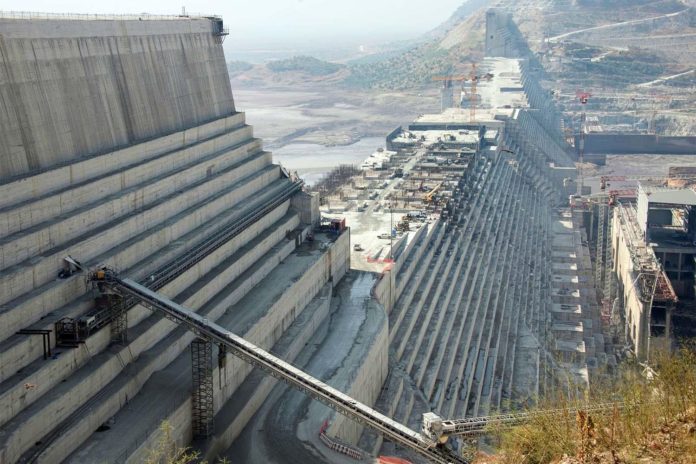By Nina Mitch
DR Congo: Talks over the Grand Ethiopian Renaissance Dam between Ethiopia, Egypt, and Sudan through the mediation of the African Union, Chairman Felix Tshisekedi have collapsed.
Initially scheduled to last two days, from Sunday 4 to Monday 5 April in Kinshasa, the talks continued until Tuesday without a Common ground between the three protagonists represented by the ministers of foreign affairs and those in charge of water and electricity. Observers from the EU and the US were also present.
The Sudanese delegation regretted the time lost since then and hopes that the mechanism will be strengthened with mediation led by the African Union (AU), but supported by the United Nations (UN), the European Union (EU), and the United States. Sudan opposes any unilateral launch of the Grand Ethiopian Renaissance Dam(GERD).
The spokesman for the Egyptian Ministry of Foreign Affairs, Ahmed Hafez, said in a statement on his official Facebook page that Ethiopia rejected all proposals and alternatives put forward by Egypt and supported by Sudan, in order to develop the negotiation process, which can allow countries and parties associated with the negotiations as observers to actively participate in the discussions, contribute to the conduct of negotiations and propose solutions to the controversial technical and legal issues.
According to the communiqué, Ethiopia also rejected an Egyptian proposal presented at the closing session of the ministerial meeting and supported by Sudan to resume negotiations under the leadership of the Congolese President who is also the Chair of the AU and with the participation of observers in accordance with the existing negotiating mechanism.
“This position reveals once again the lack of political will in Ethiopia to negotiate in good faith and its efforts to prevaricate by settling for a formal and useless negotiation mechanism, which is regrettable,” said the Egyptian spokesman.
Yet after the failure of the negotiations that former US President Donald Trump had chaired. The President of the DRC and current Chairman of the African Union, Felix Tshisekedi during his opening speech, had shown his optimism that the hatchet around the Nile would finally be buried.
“The differences around the Grand Ethiopian Renaissance Dam should not be seen as a fatality but as an opportunity for the benefit of our populations and the opening of new opportunities for cross-border and regional cooperation. They must be ironed out and that is why you are here,” said Felix Tshisekedi at the opening of the talks in Kinshasa.
The Renaissance Dam, on which work began in 2011, is one of the flagship projects of the African Union and the African Union Development Agency (AUDA-NEPAD) under the Program for Infrastructure and Development in Africa (PIDA) .
It is located in the State of Benishangul, a province in northern Ethiopia, on the Blue Nile whose source is Lake Tana which is one of the largest tributaries of the Nile, 20 km from the border with Sudan, this project with pharaonic dimensions: 1,800 m long, 155 m high and a total volume of 74,000 million m³, will be composed of 2 power plants installed at the foot of the dam. 16 turbines with a total installed power of 6,000 MW, the equivalent of 6 nuclear power plants, and estimated production of 15,000 kWh per year.
The surface area of the reservoir will be approximately 1700 km2 and the quantity of water accumulated will be 74 million cubic meters, more than the annual capacity of the Nile. This will make the Grand Renaissance the largest dam in Africa once completed.
The cost of the project is estimated at 3.4 billion euros, financed entirely by the Ethiopian government and the Ethiopians themselves from the country and the diaspora.

At the beginning of the works, many foreign investors had withdrawn because of the diplomatic conflicts around the Nile between these three countries.
Egypt, which depends on the Nile for about 97% of its irrigation and drinking water, sees the Ethiopian dam as a threat to its water supply.
The main concern for the Egyptians is that if the water flow decreases, it could affect Lake Nasser, the more downstream reservoir behind Egypt’s Aswan Dam, which produces most of the country’s electricity.
It could also impact transport on the Nile in Egypt if water levels are too low, not to mention the livelihoods of farmers who depend on water for irrigation.
Sudan, for its part, fears that its own dams could be damaged if Ethiopia proceeds with the full filling of the GERD before an agreement is reached.
According to the Minister, construction of GERD has reached 78.3% and it is expected to be completed up to 82% until the upcoming rainy season.
The largest hydropower project in Africa, the Grand Ethiopian Renaissance Dam (GERD) is set to be operational by 2023 as per schedule. According to Ethiopia’s Minister of Water, Irrigation, and Energy Seleshi Bekele, following the successful completion of the first-round filling, the second filling is going to be held during the coming rainy season in July 2021.
However, Egypt has already warned Ethiopia of negative repercussions over the disputed Nile dam.














